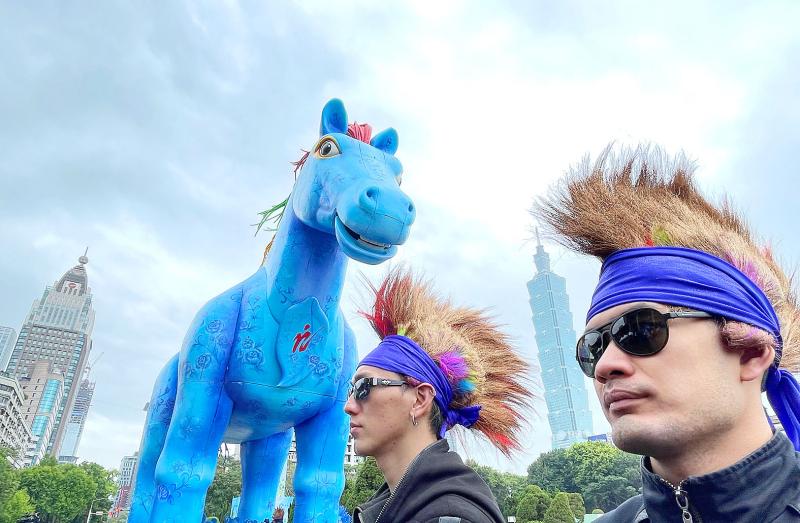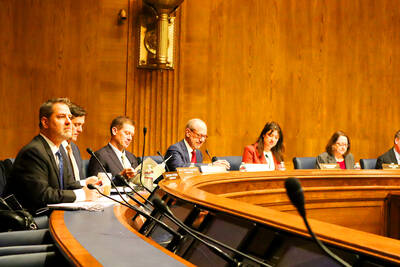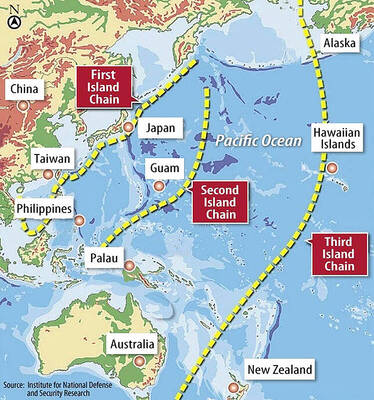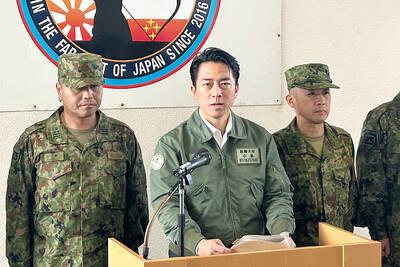Recent rains in central and southern Taiwan have not refilled water reservoirs, prompting the Ministry of Economic Affairs (MOEA) to announce that next month would bring further water restrictions to some parts of the nation.
Some areas of Miaoli County and Taichung are to be placed on “red alert,” meaning that water supplies to households and businesses would be on for five days and off for two days, the ministry said yesterday.
Parts of Changhua County closest to the border of Taichung will be included in the tighter restrictions, the ministry said.

Photo: CNA
However, Hsinchu is to be spared further restrictions thanks to water supplied via the Taoyuan-Hsinchu pipeline, Minister of Economic Affairs Wang Mei-hua (王美花) said.
“The Taoyuan-Hsinchu pipeline brings more than 200,000 tonnes of water per day to the Baoshan Reservoir (寶山水庫) and the nearby Baoshan Second Reservoir (寶二水庫) in Hsinchu County, allowing them to be drawn down much more slowly,” Wang said.
The Baoshan Second Reservoir is just 9.02 percent full, Water Resources Agency data showed.

Photo: CNA
The two reservoirs supply the Hsinchu Science Park (新竹科學園區), home to production facilities operated by Taiwan Semiconductor Manufacturing Co (TSMC, 台積電), United Microelectronics Corp (UMC, 聯電) and other tech companies.
The additional restrictions are to take effect on April 6, following Tomb Sweeping Day.
TSMC said it maintains “contingency plans for each stage of the government’s water restrictions.”
“Some TSMC fabs will slightly increase the percentage of water used from tanker trucks to improve flexibility,” the company said.
“The requirement that we cut water usage by 15 percent starting on April 6 will not affect our operations,” it said, without elaborating.
Some tech production zones in Taichung’s Houli District (后里) have their own dedicated water pipelines, so they would not be affected by the rolling two-day outages, Wang said, adding that such zones would only reduce water use by 15 percent.
Major water users would need to transition from an 11 percent to a 13 percent restriction, while other industrial users would need to follow the same rolling outages as households.
“Most buildings have water towers that hold more than a two-day supply if the water is carefully conserved,” Wang said.
“Similarly, we’ve checked that businesses have water reserves that will last them two days so that production can continue undisrupted,” Wang said. “Other areas that have their own water supplies, such as those with groundwater wells, will be allowed to continuously use those resources.”
The government is hoping that the “plum rains,” which usually start next month, would help to replenish reservoirs, and that Taiwan would have typhoons this year.
Meanwhile, the government has been seeding clouds and digging wells.
“We have to expect the best, but prepare for the worst,” Wang said. “Even if the plum rains don’t bring much rain in May, we can continue living and our businesses can continue producing.”
If the situation remains dire, the restrictions would be tightened, she said, adding that she could not predict the duration of the crisis.
Taiwan was last placed on a “red alert” in 2015 and 2002, Water Resources Agency Deputy Director-General Wang Yi-feng (王藝峰) said.
“The reservoirs are actually at lower levels than they were in either 2015 or 2002,” Wang said. “But thanks to efforts such as the Hsinchu-Taoyuan pipeline, the desalination plant and emergency wells we have managed to hold on for this long before being placed on ‘red alert.’”
Additional reporting by Reuters

LIMITS: While China increases military pressure on Taiwan and expands its use of cognitive warfare, it is unwilling to target tech supply chains, the report said US and Taiwan military officials have warned that the Chinese People’s Liberation Army (PLA) could implement a blockade within “a matter of hours” and need only “minimal conversion time” prior to an attack on Taiwan, a report released on Tuesday by the US Senate’s China Economic and Security Review Commission said. “While there is no indication that China is planning an imminent attack, the United States and its allies and partners can no longer assume that a Taiwan contingency is a distant possibility for which they would have ample time to prepare,” it said. The commission made the comments in its annual

DETERMINATION: Beijing’s actions toward Tokyo have drawn international attention, but would likely bolster regional coordination and defense networks, the report said Japanese Prime Minister Sanae Takaichi’s administration is likely to prioritize security reforms and deterrence in the face of recent “hybrid” threats from China, the National Security Bureau (NSB) said. The bureau made the assessment in a written report to the Legislative Yuan ahead of an oral report and questions-and-answers session at the legislature’s Foreign Affairs and National Defense Committee tomorrow. The key points of Japan’s security reforms would be to reinforce security cooperation with the US, including enhancing defense deployment in the first island chain, pushing forward the integrated command and operations of the Japan Self-Defense Forces and US Forces Japan, as

IN THE NATIONAL INTEREST: Deputy Minister of Foreign Affairs Francois Wu said the strengthening of military facilities would help to maintain security in the Taiwan Strait Japanese Minister of Defense Shinjiro Koizumi, visiting a military base close to Taiwan, said plans to deploy missiles to the post would move forward as tensions smolder between Tokyo and Beijing. “The deployment can help lower the chance of an armed attack on our country,” Koizumi told reporters on Sunday as he wrapped up his first trip to the base on the southern Japanese island of Yonaguni. “The view that it will heighten regional tensions is not accurate.” Former Japanese minister of defense Gen Nakatani in January said that Tokyo wanted to base Type 03 Chu-SAM missiles on Yonaguni, but little progress

NO CHANGES: A Japanese spokesperson said that Tokyo remains consistent and open for dialogue, while Beijing has canceled diplomatic engagements A Japanese official blasted China’s claims that Japanese Prime Minister Sanae Takaichi has altered Japan’s position on a Taiwan crisis as “entirely baseless,” calling for more dialogue to stop ties between Asia’s top economies from spiraling. China vowed to take resolute self-defense against Japan if it “dared to intervene militarily in the Taiwan Strait” in a letter delivered Friday to the UN. “I’m aware of this letter,” said Maki Kobayashi, a senior Japanese government spokeswoman. “The claim our country has altered its position is entirely baseless,” she said on the sidelines of the G20 summit in Johannesburg on Saturday. The Chinese Ministry